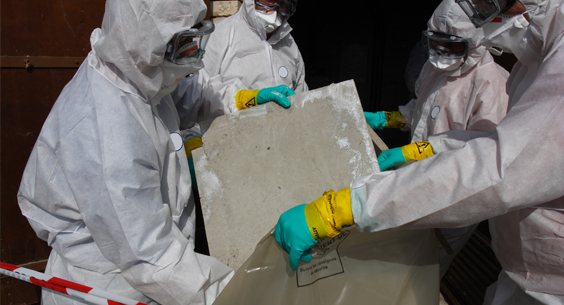
2400BC was probably the date when asbestos was first discovered. There is clear evidence that asbestos was first used at least 4,500 years ago near the lake Juojarvi in Finland. It shows that people used asbestos to make cooking pots.
A business in America began mining in Ward’s Hill quarry New York in 1858. During the industrial revolution a massive increase in asbestos production and use was noted in North America. Quebec saw its first asbestos mine open in 1874.
Asbestos became very popular throughout the World, especially in Great Britain as we entered the industrial revolution. The new machines became more and more powerful and the heat these engines and machines generated had to be controlled. The perfect insulator at the time was asbestos, which protected the steam pipes, turbines, ovens and kilns.
Mines soon opened in Russia, Australia and South Africa (most of the asbestos used here came from the mines of South Africa).
Cyprus is considered to be one of the oldest asbestos sources and until recently it has been one of the largest chrysotile asbestos producing areas in Europe. Mining and use of asbestos in Cyprus has been carried out since ancient times, and in particular during the Classical and Roman Ages. Asbestos, this fibrous mineral, has been used for making incineration plaques for the dead, shoes, wicks for lamps and for other purposes.
The Amiantos asbestos mine which operated during the period 1904 — 1988 and is situated in the Troodos Mountain Range. The Troodos range geologically constitutes part of an ancient geological ocean floor and has been known as the Troodos Ophiolite Complex. Asbestos occurs in the form of chrysotile veins scattered within serpentine (serpentinized harzburgite) appearing in the central part of the range at an altitude of 1 500 meters.
The more recent history of the mine as well as the large scale exploitation of asbestos began when asbestos was being used for the manufacturing of asbestos slates, bricks, heat insulation, pipes, motor vehicle brakes etc. The first mining lease in Cyprus was signed in 1904 in this area and included 600 hectares of land within the state forest of Troodos.
Asbestos mining, during the first decades of the last century, was carried out by primitive means, mainly simple tools and was done manually. This was the period when the largest number of personnel had been employed here. It is said that during the 1930′s the number of people employed at the mine, including those manning various services exceeded 10,000. Around the mine, a small community was created, with people living in houses or temporary dwellings. It was a time when the mine provided more income to the economy than any other single enterprise in the island.
Most people employed at the mine came from the surrounding villages, however people came for work from every corner of the island. The community provided a large and fully equipped hospital, a school, a police station, a cinema, grocery shops, a butchery, coffee shops and in general all commodities found in every small town.
The business began to become increasingly mechanized until 1949—50 when a large-scale mechanization in the mining and processing of asbestos was implemented. The annual production of asbestos fibers ranged between 20,000 to 40,000 tons. The number of employees began to decrease and many houses and in particular the temporary ones, were dismantled. Until the end of the operation of the mine in 1988, mining of asbestos was carried out in an area covering 220 hectares . In this stretch the forest was cleared, the soil was removed and every form of natural life was destroyed.
It is estimated that during this period a million tons of chrysotile asbestos fibers were mined. In order to carry out this task, 130 million tons of rocks and soil were excavated and moved. According to existing records all the quantity of asbestos fibers produced, was exported and sold to various European countries yielding approximately 75.000.000 pounds to the owner company “Cyprus Asbestos Mines Ltd”.
The Cyprus Asbestos Mines operated profitably until 1981. Since 1981 and onwards however, the demand as well as the price for asbestos in the international market plunged due to a worldwide campaign against the use of asbestos which proved to entail serious dangers for human health. Thus, in 1988 the company, which had been granted the mining license, was compelled to terminate its business having in the meantime sustained great financial loss.
The works for the restoration of the environment began in the year 1996 and includes the stabilization and reclamation of the debris. The reforestation and re-vegetationas will also take place. Priority has been given to the piles of wastes, which would under certain circumstances impose dangers to the properties situated below the mine. These works are continuing at a steady pace.